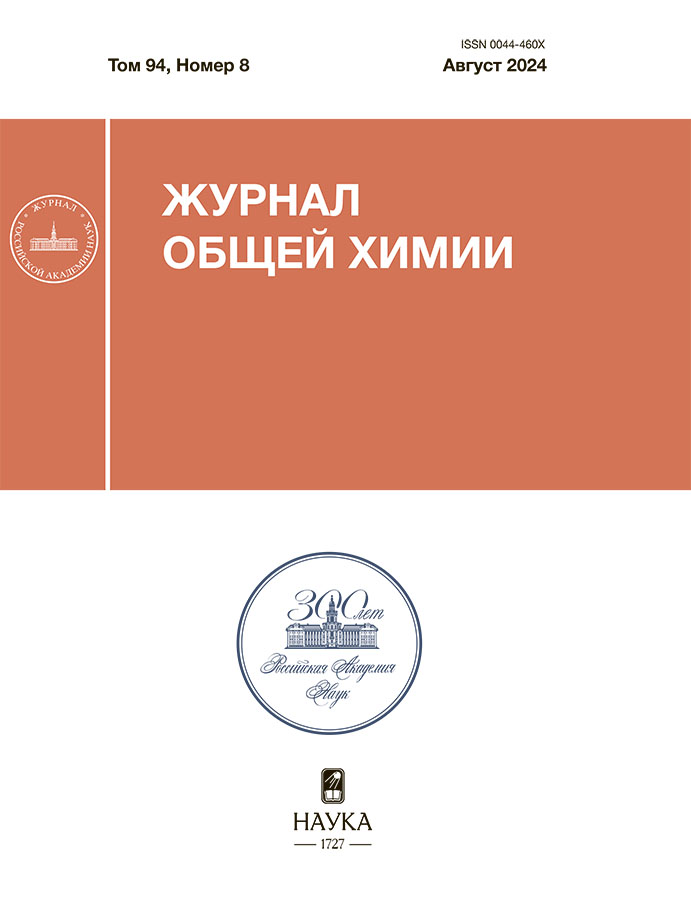卷 94, 编号 8 (2024)
Articles
Synthesis, structure, analgesic activity of N-Aryl-2,3-dimethyl-4-oxo-3,4,5,6-tetrahydro-2H-2,6-methanobenzo[g][1,3,5]oxa-diazocin-11-carboxamides
摘要
N-Aryl-2,3-dimethyl-4-oxo-3,4,5,6-tetrahydro-2H-2,6-methanobenzo[g][1,3,5]oxadiazocin-11-carboxamides were obtained by the three-component reaction of N-aryl-3-oxobutanamides, salicylic aldehyde, N-methylurea in ethanol in the presence of potassium hydrosulfate. The structure of the obtained compounds was determined by 1H, 13C NMR spectroscopy and X-ray diffraction analysis data. The analgesic activity of the synthesized compounds was studied.
 883-888
883-888


Synthesis of 1,3-bis(silyl/germyl)propanes by hydrosilylation of allylgermanes in the presence of Karstedt catalyst
摘要
The hydrosilylation reactions of allylgermanes R3GeAll (R = Cl, Me) in the presence of Karstedt catalyst with a number of phenyl- and thienyl-containing hydridosilanes were studied. It was found that the efficiency of the studied reactions is determined by a combination of several factors: the nature of the substituents at the germanium atoms in the initial olefins; the degree of hydridity of the hydrogen atoms in the initial hydridosilanes; the electronic and steric properties of the substituents at the silicon atoms of the hydridosilanes and their tendency to redistribution of deputies at silicon and germanium atoms. The synthesized compounds were identified using NMR 1H and 13C spectroscopy.
 889-895
889-895


5-(2-quinolyl)tetrabenzoporphyrin and Its complexes with zinc, cobalt, copper and manganese. Synthesis, spectral, electrochemical and electrocatalytic properties
摘要
By reacting phthalimide with quinaldine in the presence of zinc oxide, 3-(quinolin-2-ylmethylene)isoindolin-1-one was synthesized. Heating its mixture with excess phthalimide and zinc acetate leads to the formation of zinc 5-(2-quinolyl)tetrabenzoporphyrinate, which, when treated with acid, is converted to 5-(2-quinolyl)tetrabenzoporphyrin. The latter, when interacting with cobalt(II), copper(II) and manganese(II) chlorides in DMF, forms the corresponding metal complexes. The composition and structure of the obtained compounds were confirmed by a complex of physicochemical methods of analysis. The results of quantum-chemical calculations of complexes by DFT and TD-DFT methods are presented. The first absorption bands in theoretical electronic spectra are assigned to the corresponding electronic transitions in molecules. All synthesized tetrabenzoporphyrins have catalytic activity in the electroreduction reaction of oxygen; the cobalt complex exhibits the greatest activity.
 896-906
896-906


Formation of alaninate complexes of Fe(II) at various ionic strengths of the solution
摘要
The complexation in the Fe(0)–Fe(II)–L-Ala–Na(H)ClO4–H2O system was studied at a temperature of 298.15 K and the ionic strength of the Na(H)ClO4 solution I = 0.1–1.0 mol/L (cFe(II) = 1·10–3 and cL = 1·10–2 mol/l) in the range of pH = 1.0–8.2. The constants of complex formation were calculated by the method of successive approximation of theoretical and experimental oxidation functions. Based on the Debye–Huckel theory, the dependence of the constant of complex formation on the ionic strength of the solution was established. It was found that with an increase in the ionic strength of the solution, the values of the constants of formation of the forming coordination compounds decrease.
 907-912
907-912


Amino catalysts in the synthesis of cross-linked silicone diclofenac-containing composites
摘要
Low molecular mono- and diamines (3-aminopropyltriethoxysilane, hexamethylenediamine, 1,4-diaminobutane), and high molecular weight polydimethylsiloxane with terminal amine groups were studied as catalysts in the synthesis of cross-linked composite films based on polydimethylsiloxane with terminal hydroxyl groups, tetraethoxysilane a cross-linking agent and containing sodium diclofenac as a physiologically active compound. Polyethylene glycol PEG200 was used as a hydrophilizing component for the hydrophobic silicone matrix. The chemical structure of amine catalysts and polyethylene glycol presence have significant effect on structure and properties of the composites, thereby determining the kinetics and degree of prolonged release of diclofenac from the films.
 913-928
913-928


Nanofibers based on cellulose acetates
摘要
The properties of cellulose diacetate solutions in acetone and acetone–water mixtures at ratios of 95:5, 93.5:7.5 and 90:10 were studied. The optimal concentrations of cellulose diacetate solution for the formation of nanofibers from a mixture of water and acetone with a water content of 7.5 wt% were found. Cellulose diacetate nanofibers were obtained in the form of nonwoven materials with an average nanofiber diameter of 350±10 nm. In order to obtain cellulose nanofibers with a thread diameter of 350–400 nm, cellulose diacetate nanofibers were hydrolyzed in a 0.1 M potassium hydroxide solution.
 929-938
929-938


Study of the rectification purification process of inorganic acids
摘要
A flexible technology for the production of high purity inorganic acids was developed, including the stages of chemical purification, rectification, desorption, adsorption, absorption, composition correction and microfiltration. It was shown that one of the most important stages of the technology is rectification purification. Quartz and fluoroplastic experimental modules were created, on which studies of the separation coefficient were carried out. Experimental data on the separation factor were obtained using the created distillation unit. Based on the conducted research, the prospects of rectification purification in flexible technology of nitric, chloric, hydrochloric and hydrofluoric acid of high purity were shown.
 939-946
939-946











